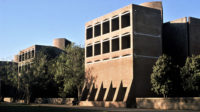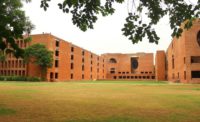Review of 'The Evolution of a Building Complex: Louis I. Kahn's Salk Institute for Biological Studies'
by Jeffry Kieffer

The Evolution of a Building Complex: Louis I. Kahn’s Salk Institute for Biological Studies, by Jeffrey Kieffer. Artifice Press, 174 pages, $24.99.
“In the temple of science are many mansions,” remarked Albert Einstein a century ago, yet in his wildest fantasies it is doubtful that he could have imagined how Louis Kahn’s Salk Institute would monumentalize his metaphor. Perhaps the most globally renowned laboratory architecture of our time, the Salk Institute (1965) marked a pinnacle in the career of Kahn. Synthesizing his experiences as an architect studying Kahn’s work, Jeffry Kieffer explores the genesis and growth of the La Jolla, California, landmark. The tale he tells illuminates design issues extending beyond this masterwork and makes this study compelling reading for more than followers of Kahn.
Rather than limiting his focus to the Salk Institute, Kieffer analyzes several Kahn projects before it (e.g., the Trenton Bath House, 1959) and after (such as the National Assembly building in Dhaka, Bangladesh, 1962–83). Additional chapters clarify Kahn’s fascination with utopianism, spiritual mysticism, and transcendental philosophy. The appendices include a transcript of a 1984 lecture by Jonas Salk hinting at a future addition to Kahn’s architecture, and a variety of letters by a who’s who of major American architects protesting the East Building Annex, supported by Salk and completed in 1995 by Anshen + Allen.
A book this ambitious could have been as daunting to approach as its subject, but Kieffer’s awareness of Kahn’s humanity as well as his art keeps it inviting. Particularly valuable is the detailed story of the visionary partnership between Salk and Kahn. So simpatico were client and architect in forging this biology lab, which has attracted premier international researchers, that Kahn credited Salk, the medical researcher who developed the Salk polio vaccine, as codesigner. Kahn and Salk performed an intricate pas de deux of reason and intuition, scientific problem-solving and aesthetic leaps of faith. A spectacular site on the California coast catalyzed the scheme of laboratory buildings as well as meeting and living quarters for scientists. Due to funding limitations, only two rows of parallel lab towers, separated by a travertine courtyard, were completed. In the center of that courtyard, a narrow water channel seemingly empties into the limitless sea and sky beyond. Composed of poured-in-place-concrete towers counterpointed by teak-paneled windows with panoramic views, the Salk Institute balances the air of a monumental ancient temple with the flavor of a contemporary industrial R & D facility. It also represented a midcourse correction for Kahn, whose earlier laboratory project, the Richards Medical Research Building (1961) at the University of Pennsylvania, squeezed scientists into awkward, rigidly configured work and study areas, with poor lighting and climate control. Kieffer underscores how Salk and Kahn paved the way for laboratories marked by open and flexible spaces, a building complex as capable of functional metamorphosis as the biological forms researched there.
By situating the Institute’s design within Kahn’s entire body of work, and by meticulously chronicling the outcome of labyrinthine design decisions that had to keep pace with Salk’s changing demands, Kieffer has presented a rarely seen face of Kahn, as pragmatically flexible as steadfastly poetic.





